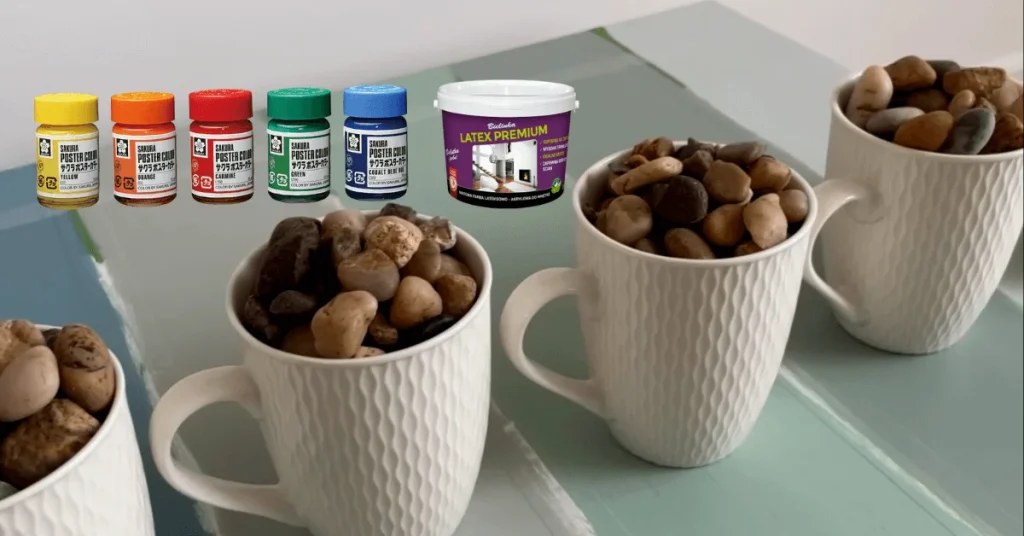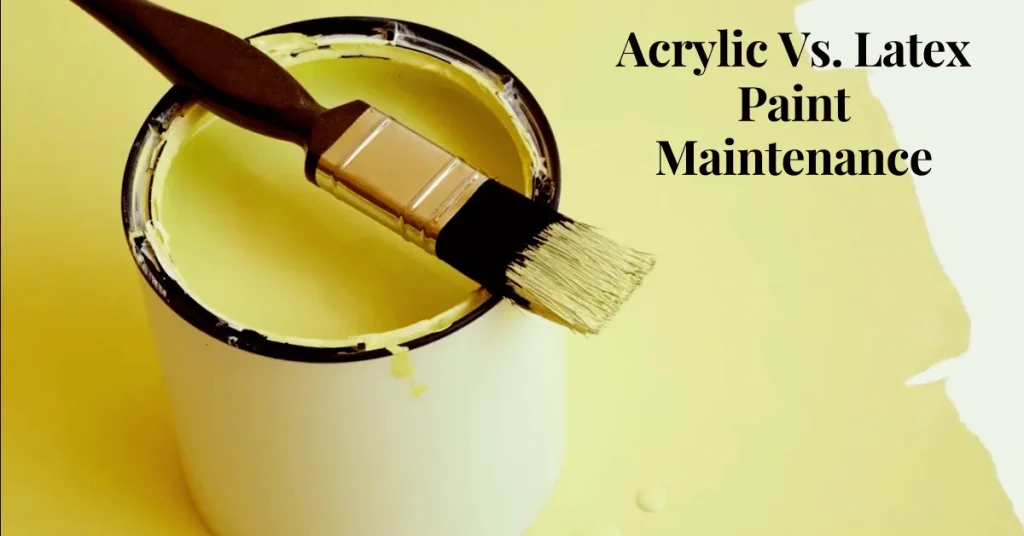When choosing a water-based paint for your project, you have to take into account numerous factors, but the primary consideration is selecting the right paint.
However, it requires some guidance, correct information, comparison, pros, cons, specifications, and applications of these paint options, which is why I’m writing this post for you. So let’s have a look at acrylic vs. latex paint.
Although both acrylic and latex are water-based paints, they differ in many ways, and the main difference is their composition. Acrylic is made from synthetic polymer, while latex is composed of natural polymer substances. They also possess distinctive drying, flexibility, durability, and many other features.
Keep reading to learn more about the two types of paint as I gonna help you determine in a better way which paints to pick up for your next painting project.
Acrylic Vs. Latex Paint (20 Differences You Must Understand)

If you’re confused between the two paints and wish to choose the one that suits your requirement, you must read this comparison between them.
So what is the difference between acrylic and latex paint? I’ve covered all the differences between the two based on my experience with them over the years.
- Composition
Acrylic is a synthetic polymer made from petroleum-based products, while latex is a natural product derived from the sap of rubber trees.
Acrylic is a synthetic polymer made from a monomer called methyl methacrylate. It is a transparent, lightweight, and durable substance that is commonly used in applications such as sign-making window glazing and as a substitute for glass.
Latex, on the other hand, is a naturally occurring polymer that is extracted from certain plants. It is used in products such as gloves and balloons and as a binder in paint.
How is latex paint made? Natural latex is a milky fluid that coagulates when exposed to air, forming a solid material. Synthetic latex is made from a monomer called styrene-butadiene and used in carpet backing and adhesives.
- Durability
Acrylic paint is known for its durability and resistance to fading, chipping, and peeling. It dries to a hard, long-lasting finish that can withstand exposure to sunlight, water, and other elements. It is ideal for use in high-traffic areas and outdoor surfaces as it has excellent weather resistance.

On the other hand, latex paint is also known for its durability, but it is not as resistant to fading and chipping as acrylic paint. It dries to a flexible finish that can expand and contract with the surface, making it ideal for use on surfaces that may experience movement or temperature changes.
- Flexibility
Acrylic paint dries to a rigid finish and does not have much flexibility. While it is durable and resistant to fading, it may crack or peel if applied to a surface that experiences significant movement or temperature changes.
Latex paint, on the other hand, dries to a flexible finish and is able to move with the surface, making it ideal for use on flexible surfaces, such as drywall, or surfaces that may experience movement, such as wooden surfaces. It has a good level of flexibility, which makes it less likely to crack or peel compared to acrylic paint.
- Final Finish
Both paints are water-based and have a similar finish, but there are some differences between paint acrylic vs latex, that can affect the final appearance of your surface when you paint it.
Acrylic paint dries to a high-gloss sheen, making it an ideal choice for surfaces that require a glossy finish, such as trim, doors, and cabinetry.
However, acrylic paint can also be found in matte, satin, and semi-gloss finishes, making it versatile for various applications.
On the other hand, latex paint dries to a low- to medium-gloss finish, making it a good choice for walls and ceilings where a shiny finish is not desired.
- Drying
Acrylic paints dry quickly and can be thinned with water, while latex paints dry more slowly and are typically thinned with a petroleum-based thinner.
Acrylic paint normally takes about 15 minutes to dry to the touch and about 24 hours to fully cure. Latex paint, on the other hand, can take anywhere from 1 to 6 hours to dry to the touch and up to 30 days to fully cure.
The drying time of both paints can be influenced by factors such as humidity, temperature, and the thickness of the paint film.

- Health Concerns
The difference between latex and acrylic paint when it comes to health is acrylic produces fumes that can cause respiratory irritation and headaches, while natural latex is hypoallergenic and does not emit fumes.
Acrylic paints are known to emit volatile organic compounds (VOCs) that can be harmful to human health if inhaled in large quantities. The fumes produced by acrylic paints can cause headaches, dizziness, and respiratory irritation, among other symptoms.
However, these fumes are typically not harmful in low concentrations and can be reduced by using low-VOC or no-VOC products.
Latex, on the other hand, is made from natural ingredients and is less harmful, but some people may have an allergic reaction to natural latex, which can cause skin irritation, itching, and in severe cases, anaphylaxis. However, these reactions are rare, and many people can safely use latex products.
In short, both latex vs acrylic paint has potential health concerns, but they vary depending on the product and individual sensitivity. So it’s important to use products made from these materials in a well-ventilated area and to follow the manufacturer’s safety instructions to minimise any health risks.
- Environmental Impact
Acrylic paint disposal and production can have significant environmental impacts due to the release of volatile organic compounds (VOCs) into the air, which contributes to air pollution and ozone depletion.
Additionally, acrylic paint production requires the use of large amounts of energy and water, and the disposal of unused paint can result in the release of harmful chemicals into the environment.

On the other hand, latex paint is made from natural materials, such as water and rubber, and is considered a more environmentally friendly option.
Latex paint has a lower VOC content than acrylic paint, and its production requires less energy and water. In addition, latex paint is easier to dispose of than acrylic paint and can be safely disposed of in a landfill without releasing harmful chemicals into the environment.
- Price
In general, latex paint is less expensive than acrylic paint, primarily because latex is more widely produced and, therefore, readily available at a lower cost.
A gallon of interior latex paint can range in price from $15 to $40, while a gallon of interior acrylic paint can cost anywhere from $20 to $50 or more.
However, it is important to note that price can vary greatly depending on the brand, quality, and finish of the paint. Higher-end brands and specialty finishes such as semi-gloss or high-gloss can cost more, regardless of whether they are acrylic or latex-based.
- Water Resistance
Acrylic paint is more water-resistant as compared to latex paint. When applied correctly, it forms an enduring and water-resistant film on the surface, making it ideal for use on surfaces that are frequently exposed to water, such as bathrooms, kitchens, and exterior surfaces. Learn more about acrylic paint waterproofing.
Latex paint, on the other hand, is not as water-resistant as acrylic paint, making it less ideal for surfaces that are exposed to water.
- Cleaning
Washing acrylic paint from surfaces or tools can be done with soap and water while the paint is still wet. But once the paint has dried, it is more difficult to remove and may require the use of solvents like alcohol or vinegar.
On the other hand, cleaning latex paint from surfaces or tools is relatively easy, as it can typically be removed with soap and water.
- Maintenance
Acrylic paint is easy to maintain as it is quite resistant and stable compared to latex paint. Acrylic doesn’t need to be re-coated or sealed with time. On the other hand, latex paint needs to be repainted with the passage, of course.
However, both types of paint can be touched up if they get scratched or scuffed, but because acrylic dries more quickly, it may be easier to touch up small areas without leaving visible brush marks.

- Versatility
Acrylic is more versatile than latex and can be used in a wide range of applications, while latex is primarily used in the production of rubber products.
Acrylic paint is more universal than latex paint in terms of its ability to adhere to a variety of surfaces. It can be used on a range of surfaces, including wood, metal, brick, concrete, and even plastic.
- Transparency
Acrylic paint is considered more transparent when it comes to acrylic vs latex paint, making it ideal for layering and glazing techniques. It dries quickly to a clear, glossy finish and is water-resistant once dry.
This makes it a great option for artists who want to build up layers of colour without obscuring underlying coatings.
Latex paint, on the other hand, is not as transparent as acrylic paint. It is a more opaque paint, meaning that it covers up the surface it is applied to and does not allow much light to pass through.
Latex paint is also thicker and more viscous than acrylic paint, making it more suitable for covering larger areas with a single coat.
Learn more: How to make acrylic paint transparent?
- Chemical Resistance
Acrylic is more resistant to chemicals than latex and can be used in harsh environments, while latex may degrade when disclosed to chemicals.
So it is recommended to use acrylic in a highly chemically contagious environment.
- Heat Resistance
Acrylic is more heat-resistant than latex and can be used in high-temperature applications, while latex may degrade when exposed to heat.
It means you can dry acrylic paint faster using heat lamps, heat dryers, or any other heating source, making your painting convenient compared to latex paint.
- UV Resistance
Acrylic is more resistant to UV rays than latex and can be used in outdoor applications without fading, while latex may fade over time when exposed to sunlight.
So it’s better to go for acrylic paint if your painted project has to face UV or direct sunlight. However, if latex paint is formulated with UV-resistant mediums, it can be used for outdoor paintings as well.
- Biodegradability
Latex is biodegradable and will break down in the environment over time, while acrylic is not biodegradable and will persist in the environment for many years.
The reason is the composition of the paints. The latest is synthesized with natural materials, or you can say organic compounds, while acrylic is made with synthetic compounds.
- Hardness
Acrylic is harder than latex and is better able to withstand wear and tear, while latex is softer and may dent or scratch more easily.
- Weather Resistance
Latex paint vs acrylic paint, which is more weather friendly? Well, acrylic is more weather-resistant than latex and can be used in outdoor applications, while latex may become brittle and crack in extreme weather conditions.
- Coverage
Latex paint provides more coverage and doesn’t require additional layers to cover the surface. In contrast, acrylic paint provides less coverage and needs to be applied in multiple coats.
FAQs
Which is better, acrylic paint vs latex paint?
Both paints are unique in their properties, depending on your requirements. However, acrylic is good for you if you want durable and thin paint. On the other hand, Latex is a better choice if you’re looking for flexibility and thickness.
Is acrylic the same as latex?
No, acrylic and latex are different in their composition and properties. Although both have water as a solvent, there are many differences between them.
Can I paint acrylic over latex?
Yes, you can paint acrylic over latex, as both are water-based and can be blended together without any serious hurdle.
What is latex paint used for?
Latex is a thick paint that is mainly used on walls to paint your home and commercial buildings. It can also be used on floors, metals, wood, and plastic to give them a colorful look.
Latex vs acrylic paint for walls, what should I choose?
Compared to acrylic, Latex paint is good for walls as it provides good coverage and costs you less. Meaning that you can paint your walls with a colorful coating spending only a few bucks.
Conclusion
In conclusion, I want to repeat that both types of paint have their own unique benefits, so it’s important to consider the project and its requirements before making a final decision.
The choice between acrylic and latex paint will depend on the specific necessities and preferences of the user.
Thank You!
- How To Buff Acrylic Enamel Paint In 5 Easy Steps? - February 2, 2024
- How To Make Acrylic Paint More Opaque? 10 Effective Methods - February 1, 2024
- How To Sketch On Canvas Before Acrylic Painting? Draw Like a Pro - January 31, 2024

